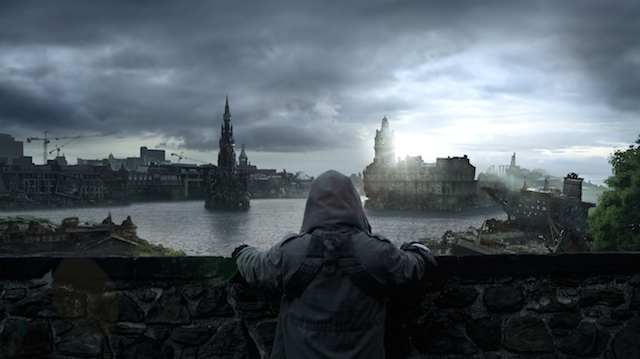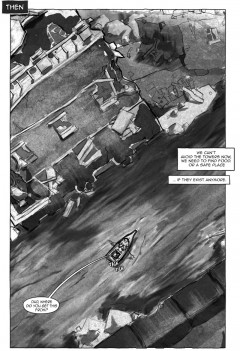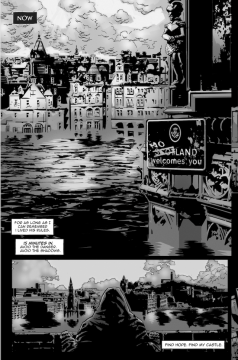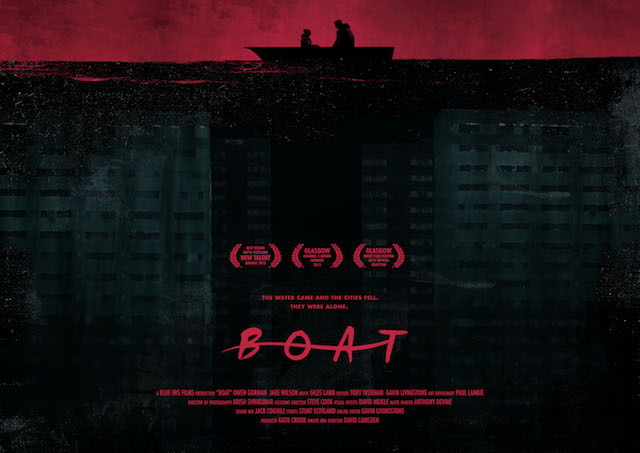“In the comic world there really isn’t any restrictions” film-maker David Lumsden on turning his short film Boat into a comic
 We’re used to the world of comics inspiring our cinema. But film maker David Lumsden chose to do things the other way round with his short film Boat, about a post-event Scotland which is now underwater, and turned it into a series of stunning black and white graphic novels. We catch up with David to find out more about turning films into comics, the rules of No Land, and how he’d survive on a boat.
We’re used to the world of comics inspiring our cinema. But film maker David Lumsden chose to do things the other way round with his short film Boat, about a post-event Scotland which is now underwater, and turned it into a series of stunning black and white graphic novels. We catch up with David to find out more about turning films into comics, the rules of No Land, and how he’d survive on a boat.
Boat is both a graphic novel and also a film about a boy and his father in a post-event Scotland where everything is flooded and people are fighting for survival – can you tell us a bit about the inspiration for this and which came first, the comic or the film?
DL: I was inspired to make the film from wanting to see Edinburgh in a different way, it came from a conversation with a cinematographer who told me that Edinburgh had been seen from most perspectives and it was getting hard to show it in a fresh light. It got me thinking about depicting the city in a post apocalyptic setting. The short film came first, but I have been keen to do a comic for years. I have always been a fan of comic books especially ones that tie in with films and I have tried to get my own comic made for a while now. It wasn’t until i saw the storyboards for Boat that i thought it could happen. So we went for it and it turned out pretty well.

Does the comic follow the film faithfully or does it develop on further with the second volume? Did you produce the film to mimic comic or vice versa?
DL: Volume 1 is based on the short film, the last frame of the film is the last panel of the comic but i would say the comic has more depth, there was scope to add more action and story elements in the comic that i was restricted with the film budget. I was able to add a lot more narrative, the film has very little dialogue and i am not too keen on adding that much voice over but with the comic i could really develop the world, the story and the characters.

The rules which the father and son live by is fundamental to the story in volume 1, was this always something which you had in your mind from the very beginning?
DL: The rules were always important in the story, it came from an idea of needing to have a structure in the middle of madness, the Dad is struggling to hold it together and him making these rules were a way to ensure there was some guidelines in their crazy world. It also showed that they had been through a lot of turmoil already. The rules were the thing that kept the characters alive but it was a device that would have to be tested at some point to create some drama and tension.
There seems to be quite a leap in tone from volume 1 to volume 2, was this always the plan or a reaction to a postitive reception for volume 1?
DL: I think the positive reaction helped give me confidence to continue the story but I always planned to return to the world. It goes back to what I could and couldn’t include in the short film. In the comic world there really isn’t any restrictions. It’s great working with artists. Its like if I can imagine it, it can be drawn! There was so much extra story and characters that were left out of the original narrative, so to be able to include what comes next for them and more of the city, really was a big incentive to keep going with the series .
The idea of Scotland becoming No Land feels quite powerful in the current political climate, was that intentional as a comment on the referendum and Scottish independence or was it just a cool name you came up with?
DL: I wish i could say that I had some big political statement with calling a flooded Edinburgh ‘No land’, but it really was just what i wanted to call the city. A lot of people have picked up on that and asked if that was my intention, the concept of No land came up well before the referendum, it came from a discussion with the VFX artist (David Meikle) on the final scene of the film, a ‘Welcome to Scotland’ sign was to be smashed up and appear on a watch tower. I was looking at the sign going back and forward on designs and it just popped into my head so we went with it. I think Scotland is pretty important to the story, it is where I have grown up so it is great to see the place in such a different light. We do go a bit further afield in future books so there may be other iconic cities that make an appearance.

How did you come to be working with artists Marc Olivent and Mark Weallans and why did they change between volumes? A styllistic choice or out of neccessity?
DL: The first book was based on the storyboards from the film and Mark was our storyboard artist i felt that the style worked well for the first book, i was always a fan of Marc Olivent’s work and I didn’t think that I would be able to work with him but I contacted him out of the blue and luckily he loved the concept and work that was done on the first book and wanted to be involved. I like that the books have a different style, it was also nice to break away from the film slightly and bring in a fresh look with the new characters/locations.
The tone is quite bleak and reminded us of Cormac McCarthy’s The Road in it’s darkness, were there any books and creators who inspired the world of Boat?
DL: That is pretty spot on, a lot of feedback we have had is that is feels like ‘the road’ on water, thats a pretty cool comparison. Pincher Martin was a a big influence on us when we were in pre-production on the film but it was a lot of concept imagery and stills that inspired the story. I am a big fan of David Finchers film ‘Seven’ I always loved the look and tone of that film – very dark but done in a beautiful way. I researched a lot of post apocalyptic material and it was after coming up with the flooded world concept that i googled some water/disaster concept art and found Anthony Devine who did all the Digital matte paintings on the film. His work on Boat won a Bafta New Talent Award which was amazing. He was great to work with and he really got the overall look of the world down perfectly.
We love the strong sense of design you have in the covers, was that something that came from the film world or was it something you knew the book needed to help make it stand out?
DL: The designs are all down to Andrei Staruiala, he is the brains behind them, Andrei is a very talented Director/Graphic Designer. He created the poster for the film which i loved. We had a few chats about what colours/designs we liked etc i think the chat lasted about 20 mins and he came up with the design for the poster, i think it worked so well. He wanted to come up with something new for the graphic novels and he really nailed it. I think his work is amazing and really catches your eye. His designs have definitely helped make the book stand out.

And finally if you were stuck on a boat what three things would you want to have with you to help aid survival?
DL: Three things i would take… i think this is cheating but i would take a survival expert. a strong supply of Ribena and a laptop… i let myself down with that answer.
You can find out more about the film version of The Boat at www.boatthefilm.com and you can purchase The graphic novel from davidlumsden.com, via Amazon KDP and from ComiXology



INTERVIEW: From Short films to comic books : Boat: The Film
August 23, 2016 @ 7:48 pm
[…] was interviewed by Alex Thomas about turning Boat the short into a graphic novel […]
August 4, 2025 @ 7:27 pm
Can you write more about it? Your articles are always helpful to me. Thank you! http://www.kayswell.com
August 5, 2025 @ 12:49 pm
Your articles are extremely helpful to me. Please provide more information! http://www.kayswell.com
August 7, 2025 @ 4:40 am
Thanks for posting. I really enjoyed reading it, especially because it addressed my problem. http://www.kayswell.com It helped me a lot and I hope it will help others too.
August 7, 2025 @ 2:42 pm
Great content! Super high-quality! Keep it up! http://www.kayswell.com
August 11, 2025 @ 7:53 am
Thanks for posting. I really enjoyed reading it, especially because it addressed my problem. http://www.kayswell.com It helped me a lot and I hope it will help others too.